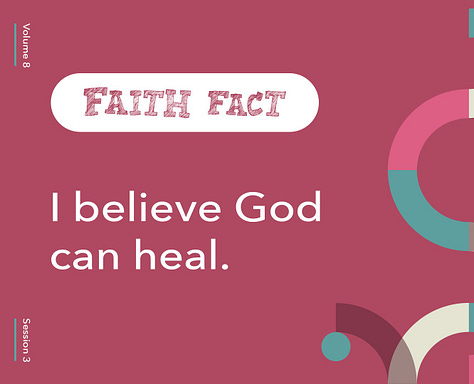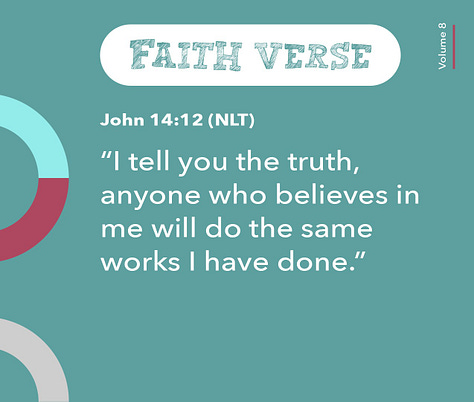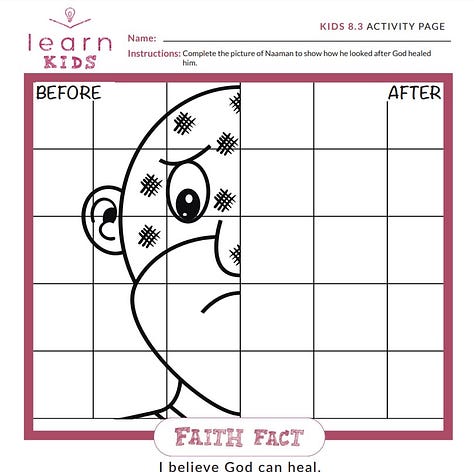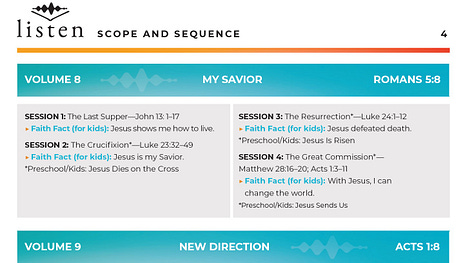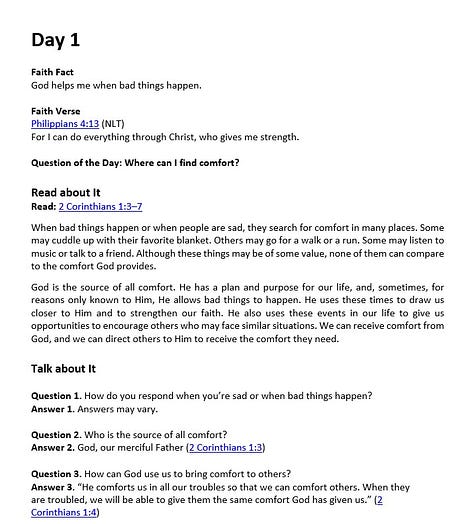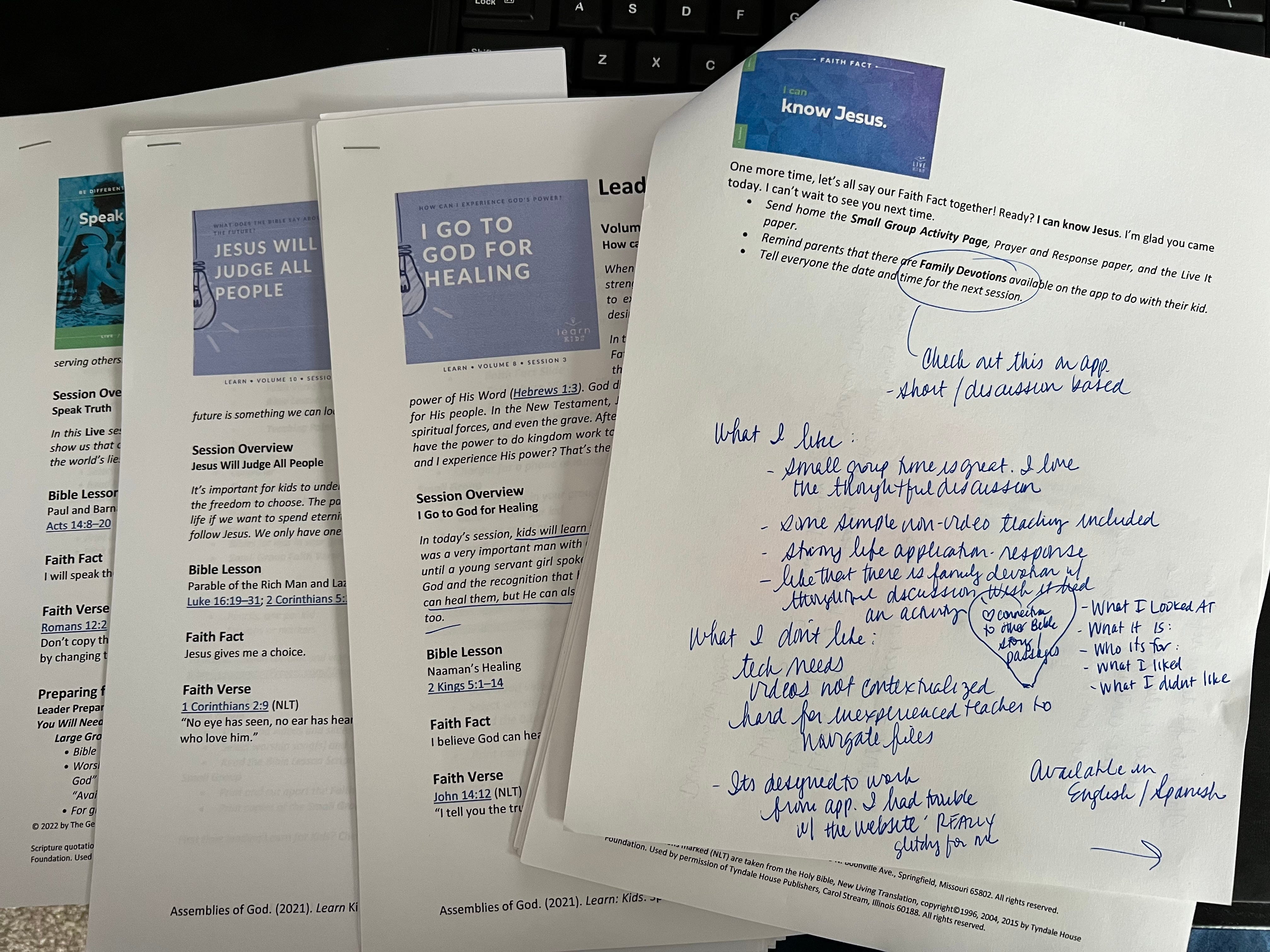REVIEW: The Bible Engagement Project
My personal and unbiased opinion which is neither advertising nor fake news
Note: I have not been paid for, commissioned to, compensated for, or even approached about, reviewing these materials. If these materials weren’t already offered free, I’d have paid for them with my own dollars so you know I’m not advertising anything. This is my unbiased and unsolicited opinion.
What is it?
“The Bible Engagement Project” is a subscription-based digital curriculum published through My Healthy Church, which is the Assemblies of God publishing house. It is App-based and can be accessed and used by all the members of a congregation via the app, or it can be printed and distributed by the church for church use. The materials contain three years of lessons (40 lessons per year) of materials at each of the following age-levels: preschool, kids, youth, and adult. It also contains family devotions to be used at home.
The materials are vertically aligned, meaning that if a church implements the entire program, everyone is studying the same thing at the same time at their own developmental level.
Currently the materials are available in English and Spanish. Bible Engagement has stated that they have plans for other languages in the future.
Who is it for?
“The Bible Engagement Project” is designed for use in the local church. Each lesson of the kids materials contain a 30-minute segment for large groups and a 30-minute segment for small groups. It would work for a Sunday school, a Children’s church, mid-week services, or for Home Group activities that include children.
With adaptation, it could be used by Christian schools, homeschool families, or missionaries looking for something to use with their own children.
The materials are theologically aligned with the views of the Assemblies of God, which can be found here.
The content of the materials is universal, and as such, these materials could be used anywhere in the world with proper adaptation. But some cultural and resource adaptations will be needed for use outside of a Western context. I’ll discuss that later.
TL;DR
I would confidently recommend these materials for a church that . . .
can use either English or Spanish materials AND
has at least some degree of internet access AND
has teachers with at least some experience using curriculum AND
can afford to provide students with pencils and paper AND
and can logistically manage breaking children into small groups.
IF a church is using them for a program that lasts longer than an hour, they will need to supplement the materials with further activities.
I would suggest that churches in non-Western contexts review all the videos and supplemental materials and decide for themselves whether they will will be achievable and whether they will benefit their students.
This curriculum could be used as a training tool for churches wanting to train teachers or improve teacher experience if it was paired with intentional mentoring. (There is an 8-part video training series on the website. I have not viewed it.)
What did I look at?
I looked at the Kids Curriculum. (This is not a review of the Preschool, Youth, or Adult curriculum.)
I reviewed the entire scope and sequence for all three years.
I read four lessons in total, as well as looking at all the supplemental materials that go with each lesson.
The lessons I read were:
Learn vol. 8, session 3: I Go to God for Healing
Learn vol. 10, session 3: Jesus Will Judge All People
Live vol. 1, session 1: Show Up
Live vol. 2, session 3: Speak Truth
I also read the corresponding family devotion for each of the above lessons.
What do I like about it?
There is a lot to love about this great curriculum.
I love that the scope and sequence is comprehensive, covering a wide variety of topics relevant to the Christian faith. I love that it is aligned with the other age-graded materials, so that everyone can be on the same topic at the same time. Which means that there is a huge element of community.
I love the thoughtful attention to faith community! (Faith happens in community!)
I love that the materials dig progressively deeper into reflection on what it means to live it our faith.
I love that the materials include some simple interactive teaching methods such as activating background knowledge, using object lessons, journaling/ drawing and discussions. (I would, however, like to see more.)
I love that there are higher-order thinking questions built into the teacher script that encourage Biblical literacy skills. (Questions that require the student to think, analyze, look for evidence, draw conclusions, synthesize, or apply the Bible.) The open-ended questions also leave room for cultural contextualization.
I love that it handles nuanced topics with truth and honesty. (For example, the lesson on healing is careful to talk about and allow students to reflect on the fact that God can heal, but he doesn’t always chose to.)
I love that the lessons have good head knowledge targets and strong, specific, heart responses and hands and feet activities.
I love that there are a lot of cross-reference activities connecting a specific lesson to other portions of Scripture.
I love that home devotions are provided.
I love that the layout is easy to follow for an inexperienced teacher.
I love that it is offered for free! What a huge blessing to churches all over the world!
What do I dislike about it?
Most of my complaints about these materials have to do with their use in multi-cultural contexts, or outside of US/ Western culture. So please consider my thoughts through the lens of your own context.
I don’t like that the materials require a certain level of technological and financial resource.
Each lesson requires you to be able to show a video and project some slides. This is most likely achievable by even smaller churches in the US or other minority world churches, but in majority world situations, this may not be achievable.
Caveat- the materials can be used without the videos or slides. This is not a video-based curriculum and is not video-dependant. Leaving them out will not diminish the teaching points. It will, however, diminish the teaching time.
Internet access is required to access the materials. This may or may not be achievable by every local church, especially in a majority world context. The good news is that they can be downloaded for print or for offline use, even from a cell phone. (It’s optimized to work from an app.)
Most lessons require pencils, paper, and sometimes an object for an object lesson. There are churches in the majority world where even providing all the kids with a piece of paper might be a challenge.
The take-home papers and coloring papers require making photocopies. This also could be limiting in resource-poor churches.
I think there is room for improvement on the multi-cultural applicability of the supplemental materials. The videos reference things familiar in US culture that may not be universal to people of other cultural backgrounds, whether inside the US or outside. They also add some humor that might be difficult for children of other cultures to differentiate from Biblical fact. However I did note that there is room in the format of the lessons to include cultural contextualization, and the videos have hosts of diverse colors, both male and female.
Some of the object lessons make cultural references, or have room for improvement in linking the object to the target idea.
I don’t like that it’s scripted. This means that the materials write out word for word what the teacher should say. When materials are scripted, inexperienced teachers will either read them word for word, or they will try to memorize them. In either case, they create a relational barrier between themselves and the students. I would much rather see materials that summarize what a teacher should say, or the point they should make, without scripting it.
I wish the home devotions provided some kind of activity the family can do together. They only provide the key teaching points and some discussion questions.
I had trouble getting the website to work correctly, and to get signed up and into the free library.
BUT. . . . REMEMBER. . . . It’s free!
Where can you get it?
My Healthy Church has just recently announced they are making these materials free. Their passion is to see the local church equipped to fulfill the Great Commission. All you have to do is go to their website and create a free account.
Already using it? Please add your thoughts and comments!
